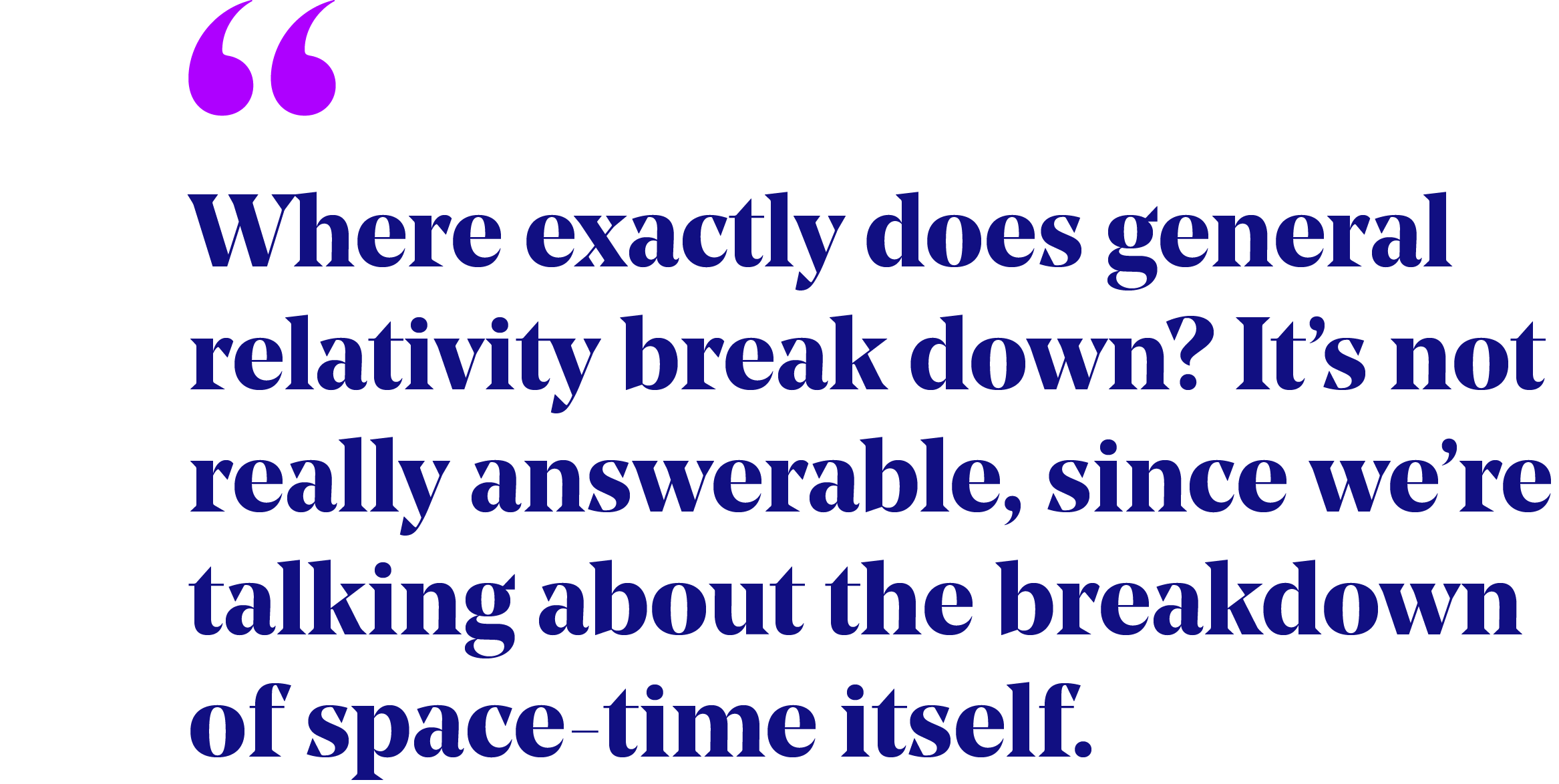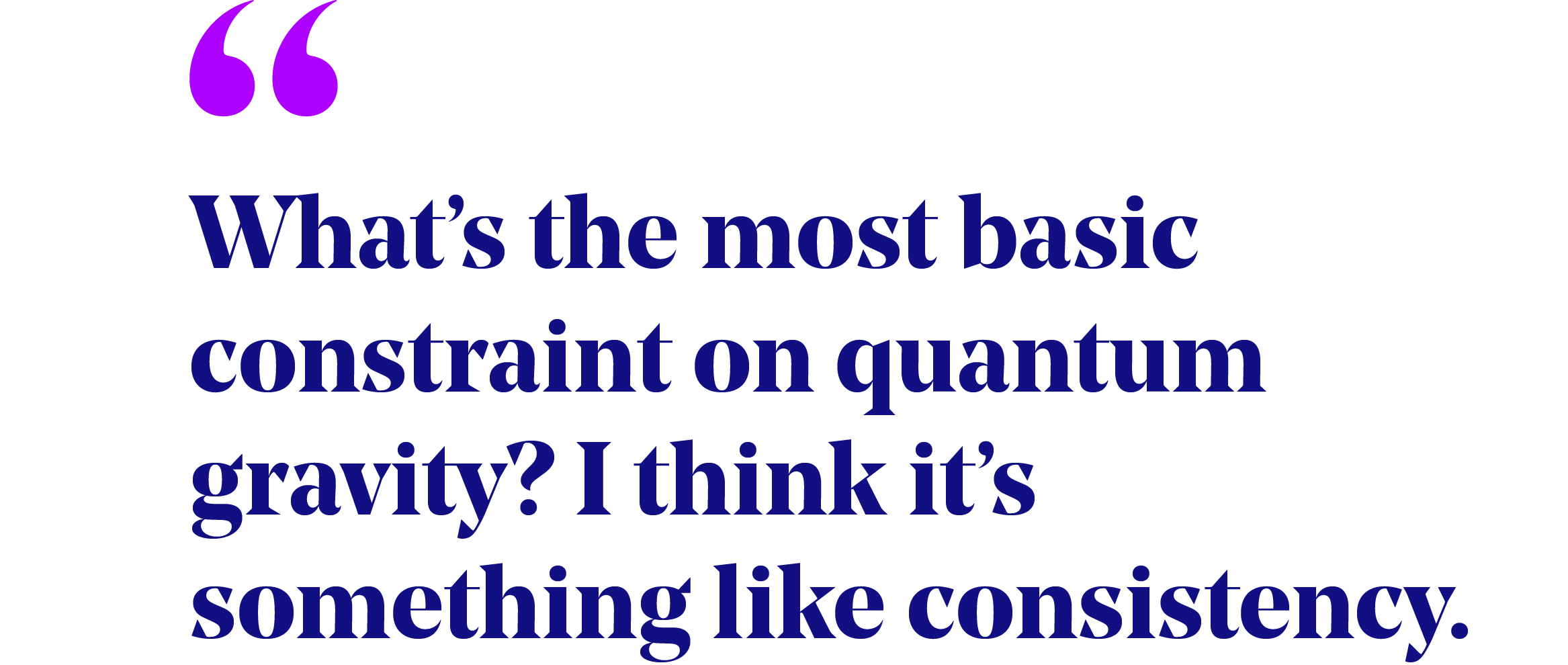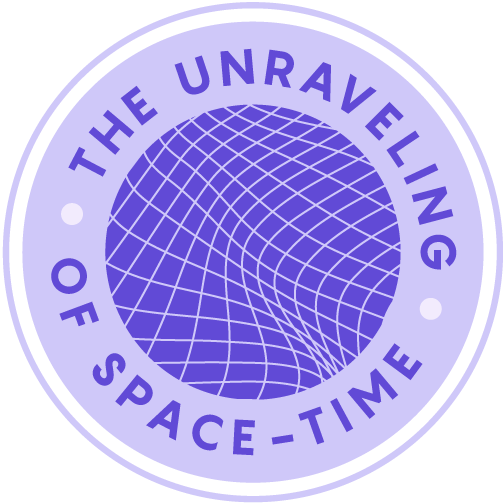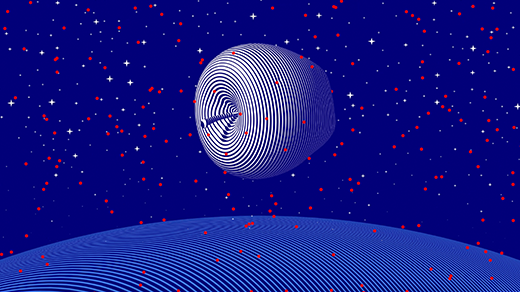The Logic That Must Lie Behind a New Physics

The search for the quantum theory of gravity “raises the question,” Karen Crowther says: “How do you go from that more fundamental theory back to space-time?”
Ilja Hendel for Quanta Magazine
It was already a mind-bending shift, last century, to go from Isaac Newton’s absolute space and universal time to Albert Einstein’s four-dimensional space-time, which is dynamic, flexible, sensitive to the touch. Einstein’s general theory of relativity showed that mass and energy warp the geometry of space-time, carving out strange contours of the universe, which suddenly became a place that could begin or end.
Physicists had barely begun to process the shift when they realized that general relativity contains the seeds of its own demise. The warping could grow pathological, with space-time curving in on itself until it tears right through, creating a breach known as a singularity. Whether singularities are tears in the universe or tears in the theory, no one could say. Either way, space-time as described by general relativity couldn’t be reality’s ultimate ingredient. And indeed, general relativity conflicts with the other profoundly successful theory of the 20th century, quantum mechanics. So physicists went on the hunt for a deeper theory — a theory of quantum gravity — that could potentially describe the world beyond space and time.
They’re still hunting. But even if they find that deeper theory, they’ll still need something else: a bridge back to space-time as we know it. We need not only a theory of quantum gravity but also a theory of how general relativity emerges from it. With one foot in space-time and one foot outside, what could that bridge possibly look like?
Karen Crowther is an Australian philosopher of physics at the University of Oslo in Norway. The author of the 2016 textbook Effective Spacetime: Understanding Emergence in Effective Field Theory and Quantum Gravity, she is part of a community of philosophers who study emergent space-time and all the ways it challenges our usual modes of thinking. How, she asks, can we conceive of the laws of physics, causation or even the universe without space-time? And how do you build a bridge to space-time when the bridge itself can’t live there?
Quanta spoke with Crowther about what it means to think outside the space-time box. The interview has been condensed and edited for clarity.
How is the search for a theory of quantum gravity different from normal science?
Usually when we’re looking for a new theory, it’s driven by some sort of empirical concern. We’ve seen something in the world that doesn’t match up with what our theories are predicting, or the theory is predicting something that we don’t observe in the world. In the case of quantum gravity, it’s not being driven by those sorts of problems. Instead, it’s about theoretical consistency or unification. We have these two conflicting pictures: quantum theory and general relativity. They’re saying different things about the world. So we want some coherence. But the places [like inside black holes or at the Big Bang] where we need to put the two theories together are places we can’t directly test or access. Maybe not now, maybe not ever.

Crowther gives a lecture titled “Think for Yourself!” in the University of Oslo’s Arne Næss Auditorium.
Ilja Hendel for Quanta Magazine
Why do general relativity’s singularities imply that space-time can’t be the ultimate reality?
We tend to think about these singularities as a “hole” or a “missing point” of space-time. But you can’t really think about them this way, because where would such a hole be located? It is, by definition, not anywhere in space-time. So where exactly does general relativity break down? It’s not really answerable, since we’re talking about the breakdown of space-time itself.
One type of singularity is a path through space-time that simply ends, meaning that objects following those paths could randomly pop in and out of existence. The singularities introduce unpredictability and indeterminism. This could indicate that general relativity is incomplete and in need of a theory of quantum gravity to replace it.

Then we have curvature singularities, which roughly correspond to the idea of space-time curvature “blowing up,” increasing without bound. These are also quite disturbing, since they’d mean we have unbounded tidal forces ripping everything to shreds. The consensus amongst physicists is that these singularities are just problems with the theory.
The suggestion is that space-time emerges from a deeper theory. From a philosophical perspective, what does it mean to say that space-time is emergent?
It means there’s something more fundamental, and that space-time only exists at our level as a kind of approximation.
There’s an idea that all arrows of explanation point toward the very small. That the smaller stuff is more basic than the bigger stuff, that atoms and quantum particles are more fundamental than tables and chairs.

Crowther stands under a bridge near the Akerselva River in Oslo.
Ilja Hendel for Quanta Magazine
But if we think that quantum gravity describes non-spatiotemporal physics, we can’t speak about length scales anymore. The very idea of length breaks down. So quantum gravity can’t be more fundamental just because it describes smaller stuff; it has to be more fundamental because it describes more stuff.
There is a worry — going back to [the philosopher] Tim Maudlin — that any theory that does not have space-time will be empirically incoherent. When we test our theories, we’re doing experiments in space and time; we’re looking at readings on a dial, which is a point in space-time, the position of the pointer at a given time. So, if we have a theory without space-time that doesn’t have things that can be detected locally, how can we test it?
The way to solve this is to recover, or derive, space-time from the non-spatiotemporal theory. We need emergence to make that link.
How might that work?
One way of thinking about emergence is in terms of a hierarchy of levels. If we think of water waves, at one level you have molecules, and then when you put a lot of them together and zoom out to lower energy or larger distances, you see the emergent phenomenon of the wave. In the case of space-time, space-time would emerge from the collective behavior of the more fundamental building blocks or “atoms” of space-time. The problem with this is that we’ve defined the idea of levels in terms of spatial lengths.

Scenes in Crowther’s office.
Ilja Hendel for Quanta Magazine
Another idea is of emergence from something prior — for example, a butterfly emerging from a caterpillar or chrysalis. It undergoes a complete transformation. This would be like talking about the Big Bang before space-time appears.
So the real challenge when it comes to emergence is how to make sense of the connection between the thing that emerges and the thing it emerges from. If there’s no connection, there’s no emergence. But the connection itself can’t be spatial or temporal.
So our usual ideas about emergence already have space and time built in, and now we need a new way to think about it. What could that look like?
I like to understand it in terms of three features: dependence, novelty and autonomy. The less-fundamental physics somehow depends on the more fundamental physics — space-time depends on the physics of quantum gravity. That would be demonstrated if general relativity is derivable from quantum gravity. But space-time and its behavior are very different from the underlying quantum gravity physics, so there’s an element of novelty — for instance, if the underlying physics is non-spatiotemporal. And finally, the behavior of space-time is also somewhat autonomous, or independent of the particular quantum-gravitational physics that it emerges from.

Is the physics of quantum gravity pointing to the idea that maybe space and time are just concepts that we’re using and not the actual stuff of the world?
There’s an idea [from the 18th-century philosopher Immanuel Kant] that we need to impose spatiotemporal concepts on the world, because we necessarily think in terms of space and time, and it’s very, very difficult for us to work without these concepts. All known physics makes use of them. So how do we conceptualize what we’re doing in quantum gravity? We’re drawing these diagrams in [our theories of quantum gravity]. But in drawing these things, we’re representing them spatiotemporally, because that’s the best we can do. But you can’t think of them as actually being anywhere. So it does really kind of make you wonder, how is this physics anymore? What are we doing? Have we pushed beyond the limits of what we’re able to do?
Kant thought that space is so basic we can’t do without it. He took the geometry to be Euclidean; he couldn’t imagine anything else. [Editor’s note: Euclidean space is flat, meaning interior angles of a triangle add to 180 degrees.] And that was shown to be incorrect — Einstein’s theory revealed that we can have different warped geometries. So that shows that even though we think there are concepts that we necessarily have to use, there could be different ones.

Waiting for the bus en route to the university.
Ilja Hendel for Quanta Magazine
Is there an approach you find most promising? Or most philosophically interesting?
String theory is quite interesting because of the idea of duality. Different forms of string theory describe very different space-time structures, with different dimensionalities, and yet they are equivalent to one another. You can’t say which one is the emergent one. So it seems to me that it must point at something deeper.
Without empirical evidence, or perhaps even the possibility of it, quantum gravity researchers seem to give more weight than usual to principles, thought experiments, even qualities like simplicity and elegance. How do those criteria sit in relation to the history of science? Is this still science?
I’m looking at the basic principles that people are assuming, and what we’re expecting a theory of quantum gravity to do. Not all of these principles or constraints mesh well together. So it might be that we have to give up or modify some. I’ve been thinking recently, what’s the most basic constraint on quantum gravity? I think it’s something like consistency. We’re trying to bring the theories of general relativity and quantum mechanics together in a consistent way to get a consistent picture of the universe. We want the mathematics to be consistent as well. These things have always played a role, especially when there have been competing theories. In periods when we are looking for new theories, physics has always become philosophical.




